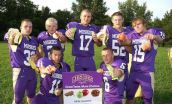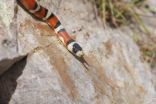(Press-News.org) In the fall of 2008, the booster club in Muscatine, Iowa took a chance. Researchers from the University of Iowa asked whether the club would add healthy foods – from apples to string cheese – to its concessions menu. And, by the way, would it also consider putting healthier ingredients in big sellers like nachos and popcorn?
These were no idle requests. Booster clubs across the United States directly support schools' athletic and extra-curricular programs like band and choir. The Muskie Boosters, for instance, raise $90,000 annually for athletics and other outside school activities. With crucial dollars at stake, clubs can be reluctant to tinker with a reliable cash generator like concession sales.
"I don't think without [revenue from] booster clubs, especially with how schools are cutting things, how they'd be able to do it," says Kate Hansen a former president of the Muskie Boosters.
The little gamble paid off for the Muskies. According to a new study published this week in the Journal of Public Health, the club netted stable sales and revenues with the healthy-food additions over one full season. Profits remained intact as well. Average sales per varsity football game rose to $6,849 in 2009 from $6,599 the year before, an increase of 4 percent. Moreover, the healthy foods made up 9.2 percent of concession sales, signaling the new products could boost overall sales. Parents and students also said they were happy with the healthy-food choices, according to surveys cited in the study.
"This study is the first to evaluate the results on satisfaction and sales of making changes to concession-stand offerings in school settings," writes the research team, led by Helena Laroche, assistant professor in internal medicine and pediatrics at the UI and the study's corresponding author. "It provides preliminary evidence that altering offerings and adding healthy options can be done by working in concert with parent groups. Furthermore, these modifications can provide reasonable revenue and profit margins without negative effects on customer satisfaction."
To date, six other school booster clubs in Iowa have added healthy foods to their concession menus, following a how-to guide written by Laroche based on her experience in Muscatine.
"Booster groups have worried that healthier items wouldn't sell, and it's important for them to make money to support student activities," Larochesays. "This shows it can be done."
The Muskie Boosters offered eight healthy foods: Apples, carrots and dip, chicken sandwiches, granola bars, pickles, soft pretzels, string cheese and trail mix. The items were sold durning the 2009 fall season at Muscatine High football games, volleyball matches and swim meets. Additionally, boosters substituted canola oil for coconut oil bars in the popcorn, and swapped the cheese in the nachos, eliminating trans fat from the products. The group advertised the new offerings in a poster and marketing campaign with the slogan, "Great taste, more variety."
While all the healthy foods sold, chicken sandwiches and pretzels dominated, accounting for 7.6 percent of all food sales, sales data showed. Sales of other items varied according to weather, venue and product visibility. Granola bars and trail mix sold better indoors, while carrots and dip were popular in benign, outdoor weather. String cheese suffered from being tucked away in a refrigerator. Pickles were especially popular with students. And, no one noticed the healthier changes to the popcorn and nachos, which continued to sell briskly.
Researchers from Cornell University's Food and Brand Lab analyzed the sales data.
"If you're a concession-stand sponsor, and you want people to eat better, and you want to make more money, add at least five healthy items," says Brian Wansink, the Cornell lab's director and a marketing professor. "There's got to be a critical mass, and we find that five's a very lucky number, and ten is even better."
To be sure, classic concession items – hot dogs, pizza and candy bars – continued to sell well. But Hansen says she noticed a shift in people's perception and attitudes about the new offerings.
"I think what it comes down to is people want to have choices," says Hansen, who was the Muscatine booster club president during the study. "We still sell hot dogs, we still sell pizza, we still sell candy bars. But everything in life is about choices, and it's important to put choices out there that meets everybody's needs and wants, and more people, it seems, want to lead healthier lives."
INFORMATION:
Contributing authors include Christopher Ford from the University of North Carolina, Chapel Hill; Xueya Cai, from the University of Rochester; and David Just and Andrew Hanks from Cornell.
The Wellmark Foundation of Iowa funded the research.
Healthy food is good for you -- and can sell, too
University of Iowa-led study shows concession stands can benefit from offering healthy foods
2014-03-11
ELSE PRESS RELEASES FROM THIS DATE:
Light pollution impairs rainforest regeneration
2014-03-11
These new findings were reported by scientists from the German Leibniz Institute for Zoo and Wildlife Research Berlin (IZW). The study – published in the British Ecological Society's Journal of Applied Ecology – is the first to show that seed-dispersing bats avoid feeding in light-polluted areas.
Working in Costa Rica with Sowell's short-tailed bats (Carollia sowelli), Daniel Lewanzik from the IZW gave the bats a simple choice. He divided a flight cage into two compartments. One was naturally dark and the other was illuminated by a sodium street lamp, the most common ...
Glucosamine fails to prevent deterioration of knee cartilage, decrease pain
2014-03-11
A short-term study found that oral glucosamine supplementation is not associated with a lessening of knee cartilage deterioration among individuals with chronic knee pain. Findings published in Arthritis & Rheumatology, a journal of the American College of Rheumatology (ACR) journal, indicate that glucosamine does not decrease pain or improve knee bone marrow lesions—more commonly known as bone bruises and thought to be a source of pain in those with osteoarthritis (OA).
According to the ACR 27 million Americans over 25 years of age are diagnosed with OA—the most common ...
Speed trap for fish catches domestic trout moving too slow
2014-03-11
PULLMAN, Wash.—Washington State University researchers have documented dramatic differences in the swimming ability of domesticated trout and their wilder relatives. The study calls into question the ability of hatcheries to mitigate more than a century of disturbances to wild fish populations.
Kristy Bellinger, who did the study for her work on a Ph.D. in zoology, said traditional hatcheries commonly breed for large fish at the cost of the speed they need to escape predators in the wild.
"The use of hatcheries to support declining wild salmon and steelhead is controversial," ...
Prescriptions for opioids stabilizing after fivefold increase in 10-year span
2014-03-11
March 10, 2014 -- Death rates from opioids have been soaring in the U.S. since the 1990s. To support the appropriate use of these controlled substances and inform public health interventions to prevent drug abuse, most states have implemented a prescription drug monitoring program (PDMP). In a latest study, researchers at Columbia University's Mailman School of Public Health evaluated the impact of these state-wide programs and found that after tripling until 2007, annual rates of prescriptions for opioid analgesics have stabilized although the effects of PDMPs on opioid ...
Impersonating poisonous prey
2014-03-10
EAST LANSING, Mich. — Imitation is the most sincere form of flattery – especially in the predator/prey/poison cycle.
In nature, bright colors are basically neon signs that scream, "Don't eat me!" But how did prey evolve these characteristics? When did predators translate the meaning?
In the current issue of the journal PLOS ONE, researchers at Michigan State University reveal that these color-coded communiqués evolve over time through gradual steps. Equally interesting, the scientists show how drab-colored, oft-eaten prey adopt garish colors to live long and prosper, ...
Claim that raw milk reduces lactose intolerance doesn't pass smell test, study finds
2014-03-10
STANFORD, Calif. — Some sour news for lactose-intolerant people who hoped that raw milk might prove easier to stomach than pasteurized milk: A pilot study from the Stanford University School of Medicine shows little difference in digestibility between the two.
The study was small — it involved 16 participants — but the lead investigator said the results were highly consistent among all the participants and deflate some of the claims surrounding raw, or unpasteurized, milk.
"It's not that there was a trend toward a benefit from raw milk and our study wasn't big enough ...
Small biomass power plants could help rural economies, stabilize national power grid, MU study finds
2014-03-10
COLUMBIA, Mo. – As energy costs rise, more Americans are turning to bioenergy to provide power to their homes and workplaces. Bioenergy is renewable energy made from organic sources, such as biomass. Technology has advanced enough that biomass power plants small enough to fit on a farm can be built at relatively low costs. Now, University of Missouri researchers have found that creating a bioenergy grid with these small plants could benefit people in rural areas of the country as well as provide relief to an overworked national power grid.
"Transporting power through ...
UV light aids cancer cells that creep along the outside of blood vessels
2014-03-10
A new study by UCLA scientists and colleagues adds further proof to earlier findings by Dr. Claire Lugassy and Dr. Raymond Barnhill of UCLA's Jonsson Comprehensive Cancer Center that deadly melanoma cells can spread through the body by creeping like tiny spiders along the outside of blood vessels without ever entering the bloodstream.
In addition, the new research, published March 6 in the journal Nature, demonstrates that this process is accelerated when the skin cancer cells are exposed to ultraviolet light. The husband-and-wife team of Barnhill and Lugassy collaborated ...
Natural selection has altered the appearance of Europeans over the past 5,000 years
2014-03-10
There has been much research into the factors that have influenced the human genome since the end of the last Ice Age. Anthropologists at Johannes Gutenberg University Mainz (JGU) and geneticists at University College London (UCL), working in collaboration with archaeologists from Berlin and Kiev, have analyzed ancient DNA from skeletons and found that selection has had a significant effect on the human genome even in the past 5,000 years, resulting in sustained changes to the appearance of people. The results of this current research project have been published this week ...
JCI online ahead of print table of contents for March 10, 2014
2014-03-10
Identification of a broadly neutralizing HIV-1 antibody in a lupus patient
Broadly neutralizing antibodies (BnAbs) recognize conserved epitopes, representing a promising strategy for targeting rapidly mutating viruses. BnAbs display a unique set of characteristics that suggest their development may be limited by immune tolerance. Interestingly, the HIV-1 infection frequency is disproportionately low among patients with the autoimmune disease lupus. In this issue of the Journal of Clinical Investigation, Mattia Bonsignori and colleagues at Duke University identified an ...
LAST 30 PRESS RELEASES:
Many mothers in Norway do not show up for postnatal check-ups
Researchers want to find out why quick clay is so unstable
Superradiant spins show teamwork at the quantum scale
Cleveland Clinic Research links tumor bacteria to immunotherapy resistance in head and neck cancer
First Editorial of 2026: Resisting AI slop
Joint ground- and space-based observations reveal Saturn-mass rogue planet
Inheritable genetic variant offers protection against blood cancer risk and progression
Pigs settled Pacific islands alongside early human voyagers
A Coral reef’s daily pulse reshapes microbes in surrounding waters
EAST Tokamak experiments exceed plasma density limit, offering new approach to fusion ignition
Groundbreaking discovery reveals Africa’s oldest cremation pyre and complex ritual practices
First breathing ‘lung-on-chip’ developed using genetically identical cells
How people moved pigs across the Pacific
Interaction of climate change and human activity and its impact on plant diversity in Qinghai-Tibet plateau
From addressing uncertainty to national strategy: an interpretation of Professor Lim Siong Guan’s views
Clinical trials on AI language model use in digestive healthcare
Scientists improve robotic visual–inertial trajectory localization accuracy using cross-modal interaction and selection techniques
Correlation between cancer cachexia and immune-related adverse events in HCC
Human adipose tissue: a new source for functional organoids
Metro lines double as freight highways during off-peak hours, Beijing study shows
Biomedical functions and applications of nanomaterials in tumor diagnosis and treatment: perspectives from ophthalmic oncology
3D imaging unveils how passivation improves perovskite solar cell performance
Enriching framework Al sites in 8-membered rings of Cu-SSZ-39 zeolite to enhance low-temperature ammonia selective catalytic reduction performance
AI-powered RNA drug development: a new frontier in therapeutics
Decoupling the HOR enhancement on PtRu: Dynamically matching interfacial water to reaction coordinates
Sulfur isn’t poisonous when it synergistically acts with phosphine in olefins hydroformylation
URI researchers uncover molecular mechanisms behind speciation in corals
Chitin based carbon aerogel offers a cleaner way to store thermal energy
Tracing hidden sources of nitrate pollution in rapidly changing rural urban landscapes
Viruses on plastic pollution may quietly accelerate the spread of antibiotic resistance
[Press-News.org] Healthy food is good for you -- and can sell, tooUniversity of Iowa-led study shows concession stands can benefit from offering healthy foods





